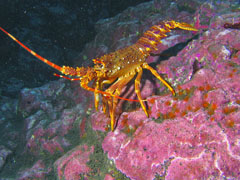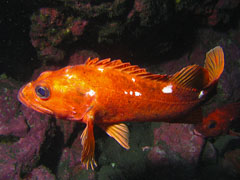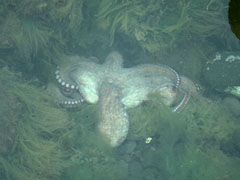See also : Whales and Dolphins Page ~ Whale News Page ~ James Clark Ross 2013 Marine Survey ~ Gough Island 2014 Dives |
 |
Jasus tristani or CrayfishKnown traditionally as Crawfish and marketed as 'Tristan Rock Lobster' Abundant crustacean found from inter-tidal pools to 200 metres deep around all the Tristan Islands and on Vema Seamount, 650 kms west of South Africa. Fished commercially by the South African based company Ovenstone and the mainstay of the Tristan economy. The fishery is world-class and now has Marine stewardship Council Accreditation - see separate Fishing Section for details. |
|||
Photo: Paul Tyler |
||||
 |
Acantholatris monodactylusor Five-finger Tristan's most abundant fish with 5 or 6 vertical bars inspiring its Tristan name. Grows up to 65 cm and a minimum size of 25cm is applied to fish caught locally from boats to conserve stocks. Photo: Paul Tyler |
|
| Found around the Tristan Islands, Vema Seamount, Amsterdam and St Paul Islands and in the SW Indian Ocean on the Austral Seamount and Walters Shoal. |
||
Sebastes capensisFalse Jacopever or Soldier Second most abundant Tristan fish. Distinctive bull-headed fish with variable colour patterns from gold to orange and red. Dorsal fin with 13 spines and growing to 46 cm. It is an ambush predator, occupying small caves and crevices and feeding on small fish and invertebrates. |
 |
Found around the Tristan Islands, any may be endemic, but similar species occur in Chile, Argentina and South Africa Photo: Paul Tyler |
 |
Nelabrichthys ornatusTristan Wrasse or Concha Small, long, slender fish which changes sex with age and is dimorphic. Juveniles are yellow-orange, with olive-green and azure stripes on young females up to about 16 cm in length. Larger fish over 17cm are male with a brownish head and three violet stripes as seen clearly in the specimen left. |
 |
Photo: Paul Tyler |
Photo: Sue Scott |
|
| Found around the Tristan Islands, Vema Seamount, Amsterdam and St Paul Islands. | ||
 |
Notorynchus cepedianusBroad Sevengill Shark or Rock Shark The most common shark of the Tristan Islands growing up to 2.5 metres long. Frequently caught and used for bait and feeding on fish and squid. Found around the Tristan Islands and in coastal waters worldwide except the North Atlantic. |
 |
| Photo: Sue Scott | Photo: Paul Tyler |
 |
Ranzania laevisSlender Sunfish Rare fish in Tristan waters, this specimen was discovered on a Tristan beach by Mark Swain in March 2015 See Wildlife News 2015. |
|||
| Unprotected sea bathing around the Tristan Islands is not advised! | ||||
 |
Octopus vulgarisOctopus or Cat Fish Locally known as Cat Fish, octopus are found from tidal pools to 100 metres deep. Some have tentacles 1m long and thrive on a diet that includes the plentiful crayfish. A worldwide species common around all the Tristan Islands |
 |
||
| Photos from Richard Grundy show left an octopus lurking in a rock-pool along a Tristan beach. Before the island swimming pool was built children were only allowed to swim in rock pools at Runaway Beach, which, though safe from shark attacks, always faced the threat of octopus. In the photo left pupil Dennis Swain is seen with a Cat Fish after pulling it from the legs of a girl in his class. The legs provide a prized fishing bait and octopus have been caught commercially in the past. | ||||
| We expect to add species to this page which may also be later sub-divided. |

